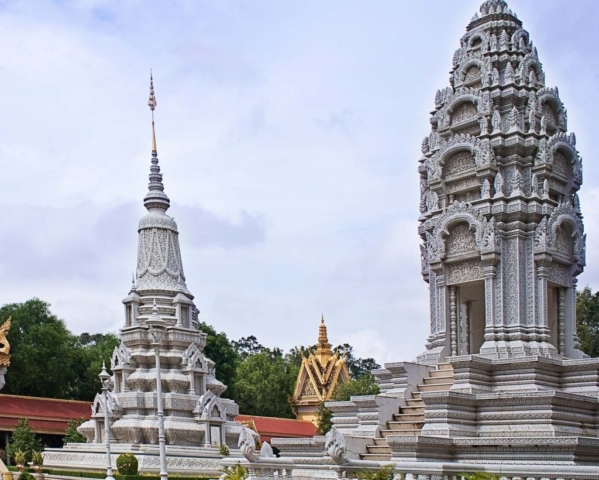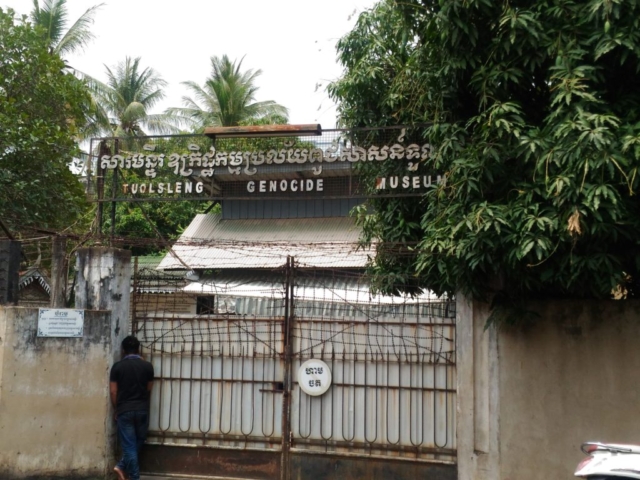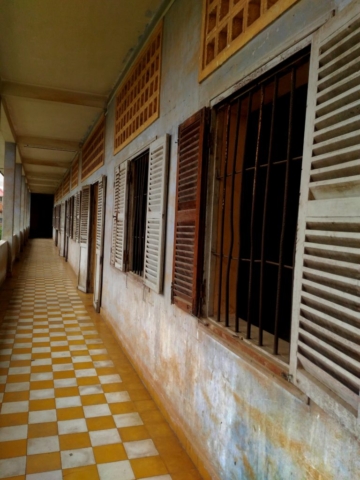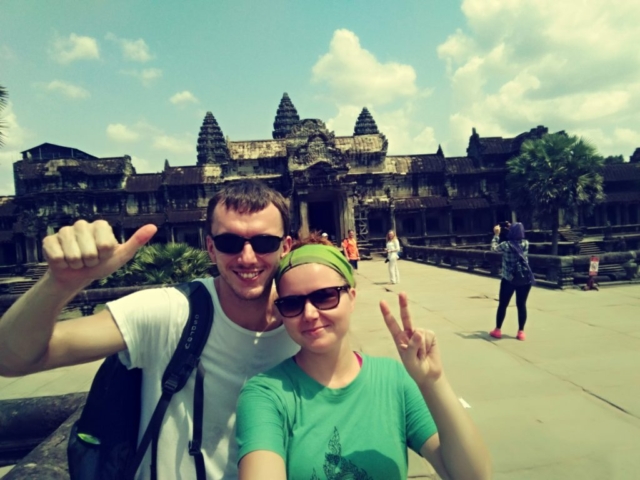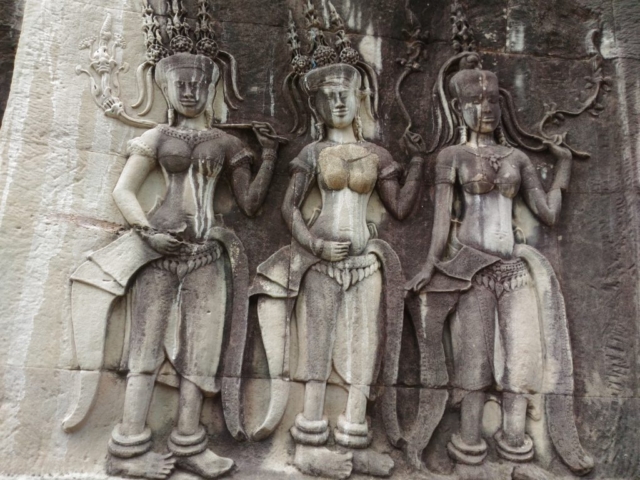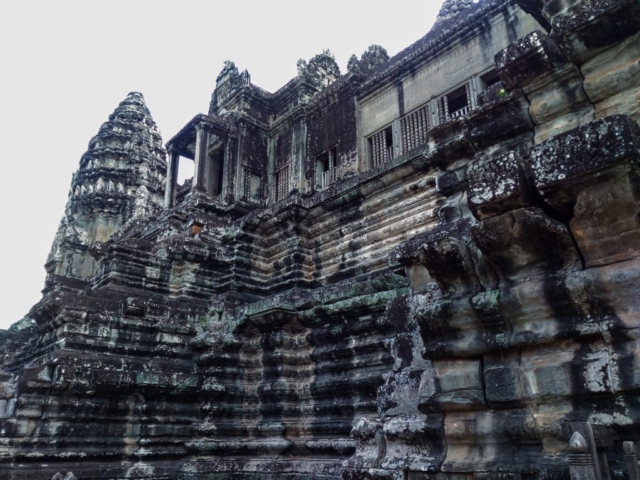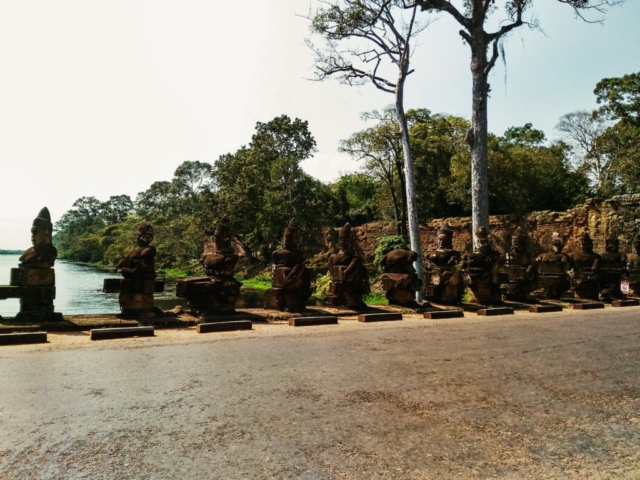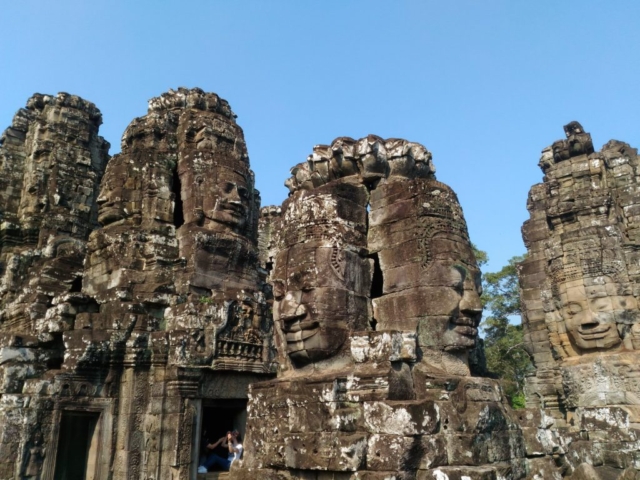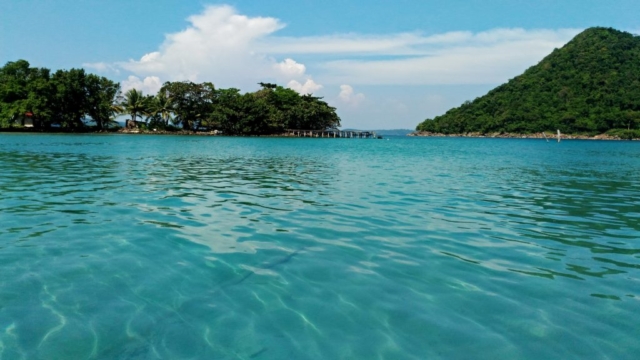Tourism in Cambodia is one of the most important sectors. In 2013, revenue from tourism increased year-on-year by 17.5%. Due to higher demand and increased travel, Emirates also started to fly to Phnom Penh with a stopover in Myanmar. This country has a lot to offer, and given that so many tourists are not here yet, I recommend to come here as soon as possible. You will not regret!
Bantey Srei
Banteay Srei is a 10th-century Cambodian temple devoted to Hindu god Shiva. Located in the Angkor area, it is located near the hill of Phnom Dei, 25 km northeast of the main group of temples that once belonged to the medieval metropolises Yasodharapura and Angkor Thom.
Banteay Srei is built mostly of red sandstone complemented by decorative wall carving. The temple is very popular with tourists and was, among other things, awarded the “Jewel of Khmer art”.
Kampot
Kampot is a city in southern Cambodia and the capital of Kampot province. It is located on the Praek Tuek Chhu River and was the most important Cambodian seaport before the city of Sihanoukville. The center is unlike most of the provincial capitals of Cambodia, composed of French colonial architecture of the 19th century.
The area and the city are well-known for high-quality peppers that are exported around the world, fish sauce and durian. Kampot is the base for excursions to Dāmrei and Bokor Mountains.
Tourists can visit pepper plantations. They can go to the fields, take part in the tasting, and even buy something. And here I have to mention the pair from Bohemia – Klara and David (cambodian.dream) who dreamed and their dream became the real. They live in the Czech Republic and in Cambodia and thanks to them, Cambodian pepper from Kampot province was imported not only into the Czech Republic but also throughout the EU.
Their project (pepper.field – https://www.kampotskypepr.cz/) supports the smallest farmers, who feed their families. And because I can imagine that doing fair trade is nothing easy and that they need a lot of energy not only on the plantations but with paperwork in the offices too, I deeply worship this couple. Well done, cambodian.dream!
Koh Ker
Koh Ker is a remote archaeological site in northern Cambodia, about 120 kilometers from Siem Reap and the ancient site of Angkor. It is a sparsely populated jungle. Tourists can only visit about twenty monuments because most of the shrines are hidden in a jungle where there are still many mines. Since 1992, Koh Ker is a UNESCO World Heritage site.
Kratié
Kratié is the capital of the province of Kratié in the eastern part of Cambodia. The city is dominated by a central market surrounded by old, French colonial buildings. The city includes large islands with white sandy beaches in the Mekong. North of the city, the Mekong River is home to a group of rare Irrawaddy dolphins, which are the main attraction.
Bokor Hill Station
Bokor Hill Station refers to a collection of French colonial buildings. Waterfalls are in the northeast.
National Museum of Cambodia
It is the largest museum of cultural history including sculptures, ceramics, ethnographic objects, etc. from the prehistoric period to the Khmer Empire. The buildings were built in Phnom Penh between 1917 and 1924. It is under the guidance of the Cambodian Ministry of Culture and Fine Arts.
The Royal Palace
Royal Palace is a complex of buildings that serves as King’s Residence of King Cambodia – now King Norodom Sihamoni, who spent his entire childhood and youth in the Czech Republic. In Prague, he studied classical dance and music at AMU. Thanks to his long-term stay in the Czech Republic, the King speaks fluent Czech.
The palace was built after King Norodom relocated the royal city from Oudong to Phnom Penh in the middle of the 19th century. It was built on an old fortress called Banteay Kev. It is oriented towards the east and is located on the west bank of the Tonle Sap and Mekong.
The Silver Pagoda
The Silver Pagoda is located on the south side of the Royal Palace in Phnom Penh. The official name is Wat Ubaosoth Ratanaram. Vihara has many national treasures including many gold and gemstones of the Buddha statues. The most prominent is the little green crystal Buddha and gold Maitreya Buddha.
The silver pagoda was inlaid with more than 5,000 silver tiles and some of its outer facades were remodeled with Italian marble. Only a small part of these tiles is available to the public. The wall that surrounds the buildings is covered with wall paintings by Reamker, painted in 1903-1904 by Cambodian artists directed by the Architect of the Silver Pagoda of Tep Nimit Mak.
Tonlé Sap
Tonle Sap literally a large river, meaning seasonally flooded freshwater lake. It forms the central part of the complex hydrological system in the Cambodian floodplain, covered by a mosaic of natural and agricultural habitats that the Mekong adds to water and sediments. The annual fluctuations in the volume of water in the Mekong, supplemented by the Asian monsoon regime, cause a unique change in the flow of the Tonle Sap.
As one of the most productive ecosystems in the world, the region has always been key to food supply in Cambodia. It turned out to be able to predominantly preserve the Angkor civilization, the largest pre-industrial settlement complex in world history. It, directly and indirectly, affects the livelihood of a large number of predominantly rural populations.
Due to inefficient management and extensive indifference to environmental issues, the lake and its surrounding ecosystem are under increasing pressure from over-exploitation and deterioration, fragmentation and loss of biotopes. In 1997 it was designated a UNESCO biosphere reserve.
Tuol Sleng Genocide Museum
Genocide Museum is located in the capital city of Cambodia – Phnom Penh. This place was a high school but it was changed into prison during the Khmer Rouge (1975-1979). In 2010, Kang Kek Iew ( the first Khmer Rouge leader) was sentenced for crimes against humanity and a serious violation of the 1949 Geneva Conventions for life imprisonment.
The complex of 5 school buildings was renamed and began to adapt for the prisoners. The buildings were closed in the electrified barbed wire, the classrooms were transformed into small prison and torture chambers, and all windows were covered with iron bars and barbed wire to prevent escape and suicide.
The exact number of prisoners isn´t known, but estimates are around 17,000 people. Prisoners were repeatedly tortured, forced to appoint family members and close coworkers who were arrested, tortured and killed too. In the first part, workers in high positions (soldiers, government officials, academics, doctors, teachers, monks, engineers …) were liquidated.
Preah Vihear
Preah Vihear Temple is an ancient Hindu temple built during the Khmer Empire, located at 525 meters in the Dangrk Mountains in Preah Vihear Province.
In 1962, after a long dispute between Cambodia and Thailand on the property, the International Court of Justice in The Hague decided that it was a temple in Cambodia. As a key building of the spiritual life of the empire, it was promoted and altered by successive kings, thus bearing the elements of several architectural styles.
On July 7, 2008, Preah Vihear was included in the UNESCO World Heritage List.
Siem Reap
The city is sometimes called the gate to Angkor Wat complex. Siem Reap has colonial and Chinese architecture in the old French Quarter and around the Old Market. The city has museums, traditional Apsara dance performances, Cambodian cultural villages, souvenir shops, farms, fishing villages and bird reserves near Tonle Sap Lake.
Angkor Wat
It was built at the beginning of the 12th century as a royal temple and capital. Temples and shrines are built of sandstone and there are brick walls too. It is a top example of Khmer architecture. One of the first Western visitors was a Portuguese missionary in 1586, who remarked, “It is a completely extraordinary structure, indescribable by a pen that can not be compared to any building elsewhere in the world.” They are the best-preserved complex in Cambodia even after being hidden for hundreds of years in the jungle. The complex has become a symbol of Cambodia and has been depicted on the national flag since 1863. They are the only historic buildings that survived the rule of the Khmer Rouge. In 1992, it was declared a UNESCO World Heritage Site.
Angkor Thom
The new capital city, after Angkor was plundered in 1177 during the invasion of Chama army. The name means “Big City”. There is a 100m wide ditch around the walls. We can see the preserved buildings include the central Bayon Temple. The palace or other buildings, unfortunately, didn´t survive, because they were built mainly from wood.
The Prohm
The modern name of the temple, the original name was Rajavihara. It was built at the end of the 12th century and at the beginning of the 13th century in Bayon style. Unlike most Angkorian temples, it is in the state in which it was found. Buildings are the victims of the jungle, but you will not forget about this place!
Phnom Kulen
Phnom Kulen is a mountain range and part of Phnom Kulen National Park in Siem Reap Province. The mountain range is located 30 km north of Angkor Wat. There is a sacred place at the top of the hill and is considered a holy mountain. Preah Ang Thom is a 16th-century Buddhist monastery with a large Buddha statue. Chup Preah is a stream flowing into the valley of the mountains. The Kulen Mountains have two waterfalls.
Kbal Spean
Banteay Chhmar
Banteay Chhmar is a village in the Thma Puok district of Banteay Meanchey province in Cambodia northwest. The massive temple of Banteay Chhmar, along with its shrines and reservoirs, includes one of the most important and least understood archaeological complexes from Cambodian Angkor.
This is one of two places outside Angkor with mysterious faces. Due to its remote location and proximity to the Thai border, the complex is exposed to large looting.
In 1998, 2000 and 2002, the temple was listed as one of the world’s 100 most-endangered sites in the World Heritage List.
Koh Rong Sanloem
Island is near the coast of Sihanoukville. The terrain is mostly hilly with several medium-sized mountains, the interior is covered with dense jungle, but the coast is characterized by a number of sandstone rock formations and beautiful beaches. There are two recognizable villages – one to the north and one to the south. The island is administered by the Cambodian Navy. There is her base too. The vast jungle of the island is a habitat for a large number of endemic species of invertebrate animals.








